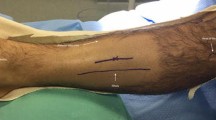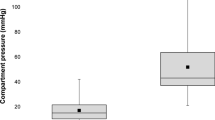Abstract
Background
Chronic exertional compartment syndrome (CECS) is an overuse disorder typically affecting an athletic population. CECS is a diagnosis based on history and intracompartmental pressure (ICP) testing. CECS patients can be treated surgically by fasciotomy; however, research on the relationship between ICP and patient symptoms and also between ICP and patient-reported outcome post-fasciotomy is limited. This study aims to (1) assess functional outcome and patient satisfaction post-fasciotomy and (2) identify any potential correlation between ICP and reported levels of pain.
Methods
138 CECS patients who had ICP measurements and subsequently underwent fasciotomy were identified from our regional service for exercise-induced lower limb extremity pain between January 2000 and March 2017. Clinical outcomes were recorded at the time of ICP testing and in the post-operative follow-up clinic. Pain was reported using a verbal rating scale (VRS) (‘low’, ‘moderate’ or ‘high’) or as a visual analogue score (VAS) 0–10 (0 = least painful, 10 = most painful). Spearman’s ranked correlation test was used to calculate correlation between ICP and reported pain.
Results
A total of 138 patients were eligible for inclusion in this study (mean age 29.7 ± 9.7 years, 110 M, 28 F) of which 109 patients (VRS n = 61, VAS n = 48) reported pain level at pre- and post-operative stages. Mean pre-operative VAS score was 8.52 ± 0.71, and decreased to 0.77 ± 0.69 post-operatively. An insignificant positive correlation (r = 0.046, two-tailed p = 0.76) was found between VAS pain and ICP. A significant moderate positive correlation (r = 0.497, two-tailed p = 0.01) was found between VRS pain and ICP.
Conclusion
Fasciotomy significantly reduces pain and increases activity levels in CECS patients. ICP was found to positively correlate with patient-reported pain.




Similar content being viewed by others
References
McLaughlin N, Heard H, Kelham S (2014) Acute and chronic compartment syndromes: know when to act fast. J Am Acad Phys Assist 27(6):23–26
Blackman PG (2000) A review of chronic exertional compartment syndrome in the lower leg. Med Sci Sports Exerc 32(3 Suppl):S4–S10
Brewer RB, Gregory AJ (2012) Chronic lower leg pain in athletes: a guide for the differential diagnosis, evaluation, and treatment. Sports Health 4(2):121–127
Davis DE, Raikin S, Garras DN, Vitanzo P, Labrador H, Espandar R (2013) Characteristics of patients with chronic exertional compartment syndrome. Foot Ankle Int 34(10):1349–1354
Paik RS, Pepples D, Hutchinson MR (2013) Chronic exertional compartment syndrome. BMJ 346(7896):35–37
Dunn JC, Waterman BR (2014) Chronic exertional compartment syndrome of the leg in the military. Clin Sports Med 33(4):693–705
Murdock M, Murdoch MM (2012) Compartment syndrome: a review of the literature. Clin Podiatr Med Surg 29(2):301–310
Van der Wal WA, Heesterbeek PJ, Van den Brand JG, Verleisdonk EJ (2015) The natural course of chronic exertional compartment syndrome of the lower leg. Knee Surg Sports Traumatol Arthrosc 23(7):2136–2141
Styf JR, Korner LM (1987) Diagnosis of chronic anterior compartment syndrome in the lower leg. Acta Orthop Scand 58:139–144
Van den Brand JG, Verleisdonk EJ (2004) Near infrared spectroscopy in the diagnosis of chronic exertional compartment syndrome. Am J Sports Med 32:452–456
Verleisdonk EJ, van Gils A, van der Werken C (2001) The diagnositc value of MRI scans for the diagnosis of chronic exertional compartment syndrome of the lower leg. Skeletal Radiol 30:321–325
Pedowitz RA, Hargens AR, Mubarak SJ, Gershuni DH (1990) Modified criteria for the objective diagnosis of chronic compartment syndrome of the leg. Am J Sports Med 18(1):35–40
Tiidus PM (2014) Is intramuscular pressure a valid diagnostic criterion for chronic exertional compartment syndrome? Clin J Sport Med 24(1):87–88
Roscoe D, Roberts AJ, Hulse D (2015) Intramuscular compartment pressure measurement in chronic exertional compartment syndrome: new and improved diagnostic criteria. Am J Sports Med 43(2):392–398
Stubhaug A, Breivik H (2016) Chronic compartment syndrome is an under-recognized cause of leg-pain. Scand J Pain 1(12):53–54
Gilmour H (2015) Chronic pain, activity restriction and flourishing mental health. Health Rep 26(1):15
Gatzounis R, Schrooten MG, Crombez G, Vlaeyen JW (2014) Interrupted by pain: an anatomy of pain-contingent activity interruptions. Pain 155(7):1192–1195
Orlin JR, Lied IH, Stranden E, Irgens HU, Andersen JR (2016) Prevalence of chronic compartment syndrome of the legs: implications for clinical diagnostic criteria and therapy. Scand J Pain 31(12):7–12
Beck JJ, Tepolt FA, Miller PE, Micheli LJ, Kocher MS (2016) Surgical treatment of chronic exertional compartment syndrome in pediatric patients. Am J Sports Med 44(10):2644–2650
Winkes MB, van Zantvoort AP, de Bruijn JA, Smeets SJ, van der Cruijsen-Raaijmakers M, Hoogeveen AR, Scheltinga MR (2016) Fasciotomy for deep posterior compartment syndrome in the lower leg a prospective study. Am J Sports Med 44(5):1309–1316
Pasic N, Bryant D, Willits K, Whitehead D (2015) Assessing outcomes in individuals undergoing fasciotomy for chronic exertional compartment syndrome of the leg. Arthroscopy 31(4):707–713
Roberts AJ, Krishnasamy P, Quayle JM, Houghton JM (2014) Outcomes of surgery for chronic exertional compartment syndrome in a military population. J R Army Med Corps. Mar 31:jramc-2013
McCallum JR, Cook JB, Hines AC, Shaha JS, Jex JW, Orchowski JR (2014) Return to duty after elective fasciotomy for chronic exertional compartment syndrome. Foot Ankle Int 35(9):871–875
Packer JD, Day MS, Nguyen JT et al (2013) Functional outcomes and patient satisfaction after fasciotomy for chronic exertional compartment syndrome. Am J Sports Med 41:430
Slimmon D, Bennell K, Brukner P, Crossley K, Bell SN (2002) Long-term outcome of fasciotomy with partial fasciectomy for chronic exertional compartment syndrome of the lower leg. Am J Sports Med 30(4):581–588
Brennan F, Kane S (2003) Diagnosis, treatment options, and rehabilitation of chronic lower leg exertional compartment syndrome. Curr Sport Med Rep. 2:247–250
Cook S, Bruce G (2002) Fasciotomy for chronic compartment syndrome in the lower limb. ANZ J Surg 72(10):720–723
Verleisdonk E, Schmitz R, Werken C (2004) Long term results of fasciotomy of the anterior compartment in patients with exercise-induced pain in the lower leg. Int J Sports Med 25(3):224–229
Roberts AJ, Krishnasamy P, Quayle JM, Houghton JM (2015) Outcomes of surgery for chronic exertional compartment syndrome in a military population. J R Army Med Corps 161:42–45
Baumgarten KM (2013) Chronic exertional compartment syndrome: are surgical outcomes worse in soldiers compared with civilians. J Bone Joint Surg Am 95:e481–e482
Shah S, Miller B, Kuhn J (2004) Chronic exertional compartment syndrome. Am J Orthop 33(7):335–341
Trease L, Every B, Bennell K et al (2001) A prospective blinded evaluation of exercise thallium-201 SPET in patients with suspected chronic exertional compartment syndrome of the leg. Eur J Nucl Med 28(6):688–695
Jensen MP, Tomé-Pires C, de la Vega R, Galán S, Solé E, Miró J (2017) What determines whether a pain is rated as mild, moderate, or severe? The importance of pain beliefs and pain interference. Clin J Pain 33(5):414–421
Nauck T, Lohrer H, Padhiar N, King JB (2015) Development and validation of a questionnaire to measure the severity of functional limitations and reduction of sports ability in German-speaking patients with exercise-induced leg pain. Br J Sports Med 49(2):113–117
Schubert AG (2011) Exertional compartment syndrome: review of the literature and proposed rehabilitation guidelines following surgical release. Int J Sports Phys Ther 6(2):126
Author information
Authors and Affiliations
Corresponding author
Ethics declarations
Conflict of interest
Dr JPH Tam, Mr AGF Gibson, Mr JRD Murray and Dr M Hassaballa declare that they have no conflict of interest.
Additional information
A. G. F. Gibson: Retired from Avon Orthopaedic Centre, Southmead Hospital, Westbury-on-Trym, Bristol, BS10 5NB, UK.
Rights and permissions
About this article
Cite this article
Tam, J.P.H., Gibson, A.G.F., Murray, J.R.D. et al. Fasciotomy for chronic exertional compartment syndrome of the leg: clinical outcome in a large retrospective cohort. Eur J Orthop Surg Traumatol 29, 479–485 (2019). https://doi.org/10.1007/s00590-018-2299-3
Received:
Accepted:
Published:
Issue Date:
DOI: https://doi.org/10.1007/s00590-018-2299-3




